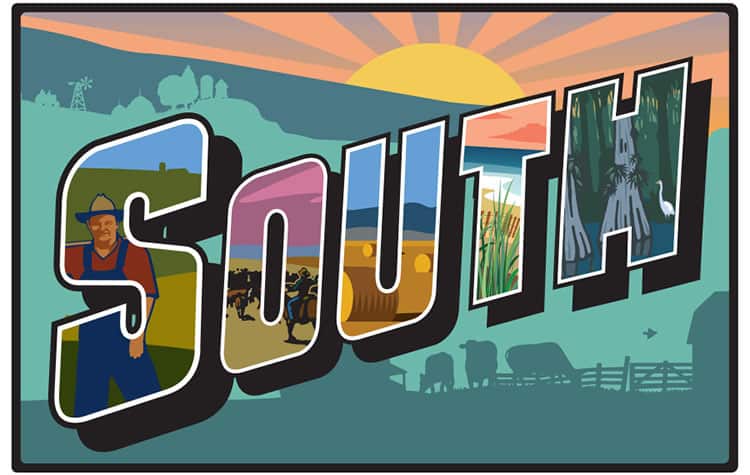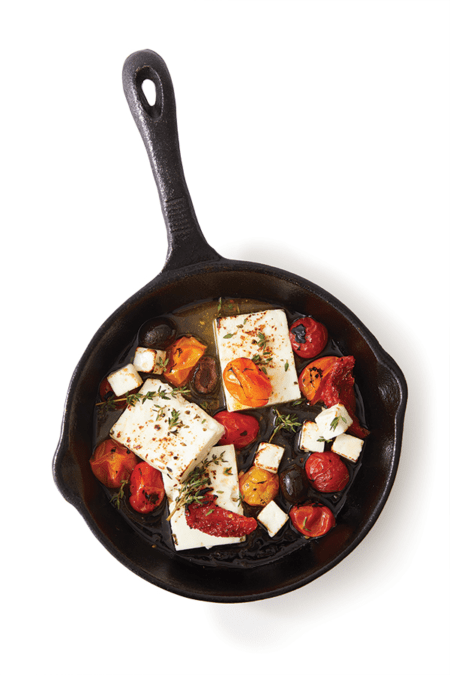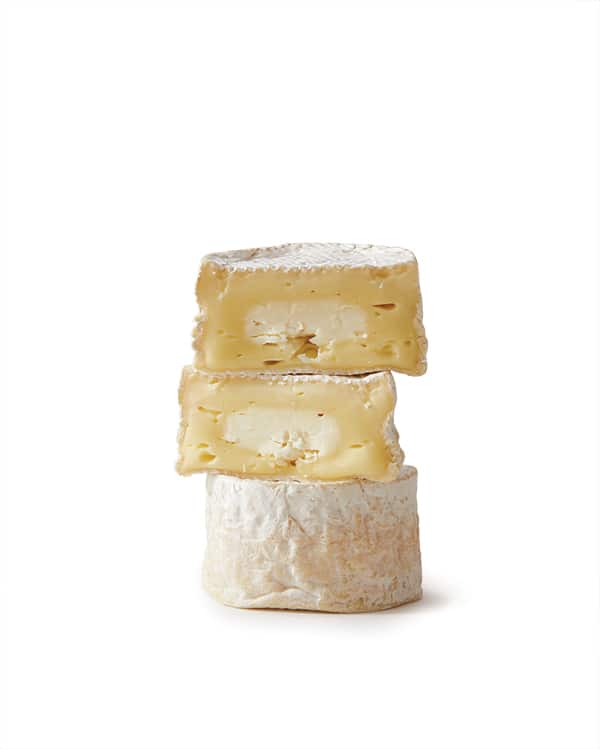
For our 2017 list of The Best Cheeses of the Year, we turned our focus to the good ol’ US of A! Over the next few weeks, we’ll share our top picks for wedges and wheels in the Northeast, South, Midwest, and West. Find the best of what your area has to offer, explore what makes each cheese special, and learn what the experts pair it with.
Written by Amanda Rae Busch, Lynn Freehill-Maye, Seánan Forbes, Nicole Haase, Hannah Howard, Kristine Jannuzzi, Kara Kaminski-Killiany, Melissa Paesan, Bridget Shirvell, and Marimar Toledo.
Photographed by Evi Abeler | Styled By Kristin Stangl | Illustrated by Neal Aspinall
Cumberland
Sequatchie Cove Creamery, Sequatchie, Tenn.
Cumberland gets its name from the world’s longest hardwood-forested plateau, which envelops Sequatchie Cove Creamery. “It was the first cheese we made in 2010 when we started the business,” says Padgett Arnold, who owns and runs the solar-powered farm with her husband, Nathan. Inspired by the classic farmhouse tommes of France, such as Tomme de Savoie, Cumberland is smooth, fruity, and rustic with an earthy rind.Since it’s made daily with raw cow’s milk from Sequatchie’s own herd, Cumberland delivers a strong expression of seasonality and geography, Padgett says. Best in its class at the 2017 United States Championship Cheese Contest, Cumberland is positively dreamy melted into grits or paired with pepper jelly.
Cottonseed
Boxcarr Handmade Cheese, Cedar Grove, N.C.
Siblings Austin and Samantha Genke started Boxcarr Handmade Cheese in 2014, and already their delicate, gooey Cottonseed has nabbed a 2017 Good Food Award. It’s little wonder—this bloomy-rind square is wonderfully lactic, with notes of buttered mushroom and truffle. When ripe, the paste nearly turns liquid. Made with Jersey and Holstein cow’s milk from a neighboring farm and Alpine, Nubian, and Sannen goat’s milk from another nearby dairy, Cottonseed is a favorite of Boxcarr cheesemaker Alessandra Trompeo. “It’s really fantastic, creamy, and briny,” she says. The cheese is only available from May until sometime in fall when the goat’s milk supply runs out, so scoop some up if you have the chance.
Old Drovers Road
Looking Glass Creamery, Fairview, N.C.
Farmers have been driving livestock down Old Drovers Road to reach Charlotte for generations. “The road goes right through the creamery,” says Andy Perkins, who owns Looking Glass Creamery with his wife, Jen. Their eponymous English-style cheddar “is perfect to pack for a long journey,” he says. Its firm, toothsome texture and buttery tang make it great for turkey sandwiches, too.
Marinated Feta in Olive Oil
Split Creek Farm Anderson, S.C.
Split Creek Farm has been crafting award-winning fresh goat feta for more than three decades. “We serve it with watermelon and cucumber, (and use it) in manicotti,” says farm manager Jessica Bell. When the last savory cubes are plucked from the jar (it’ll happen fast), the leftover marinade adds fragrant flavors of sun-dried tomatoes, garlic, and herbs to pasta and salads.
Thomasville Tomme
Sweet Grass Dairy, Thomasville, Ga.
Jessica Little, co-owner of Sweet Grass Dairy, has a sweet spot for Thomasville Tomme. Not only is it named after her hometown in Georgia, “it’s the very first cheese we learned how to make,” she says. When Jessica and her husband, Jeremy, took over Sweet Grass Dairy in 2002, they hired a French cheesemaking consultant. “He didn’t speak much English, so we communicated through cheese,” Little says. This wheel is the delicious fruit of that collaboration.
Perhaps unsurprisingly, this subtly complex raw cow’s milk cheese is crafted in the style of a French farmhouse wheel. Aged at least 60 days to coax out earthy flavors and a creamy, semi-soft texture, “it makes the best grilled cheese in the world (when paired with) bacon and garden tomato,” Little says.
Woolly Rind
Green Dirt Farm, Weston, Mo.
In 1996, Sarah Hoffman and John Spertus left their medical careers in Seattle and moved to Missouri to live out their dream of raising their family on a farm. A few years later, they bought a dozen Katahdin sheep and a dozen Gulf Coast sheep. Today, they milk a herd of about two hundred pasture-raised ewes in Missouri and craft yogurt and cheeses from the milk, including their award-winning Woolly Rind.
“Woolly Rind was inspired by Camembert,” says Rachel Kleine, Green Dirt Farm’s head cheesemaker. Its namesake Penicillium candidum rind covers a lush, mild, soft-ripened wheel. When young, its lemon curd flavor is balanced by a buttery texture. As it ripens, it becomes more complex, grassy, and mushroomy. At any age, it’s a perfect match for sparkling wine, whose effervescence balances the rich paste.
Shepherds Manor Tomae
Shepherds Manor Creamery, New Windsor, Md.
Colleen and Michael Histon, proprietors of Maryland’s first sheep dairy, have been raising ewes and making cheese on the outskirts of New Windsor since 2008. “[Tomae] is the hardest, most artisanal cheese I make, and it takes the most work,” says Colleen, who salts, washes, and turns the wheels in her aging room every day. “I’ve had plenty of people tell me it’s the only cheese I should ever make.” Some judges might agree: Tomae placed first in its category at the 2017 American Cheese Society competition. The Histons age the straw-colored, raw-milk rounds for at least 60 days and up to 10 months, at which point Tomae becomes dense and grateable. The cheese’s nutty, complex flavors are a beautiful foil for a juicy, mellow Rioja.
Quark
Hemme Brothers Creamery, Sweet Springs, Mo.
Hemme Brothers Creamery is a true family farm—brothers Nathan, John, Michael, and Aaron, along with their parents, Janet and David Hemme, turned to artisanal cheesemaking as a way to support the whole family. “We’ve only been making cheese for a year, and we’ve really been able to find our niche,” says Nathan.
Their quark—a nod to the family’s German heritage—is off to a strong start, winning first place in its category at the 2017 American Cheese Society Judging & Competition. It’s creamy and slightly salty, with just the right amount of tang. Try it on toast with sliced cucumbers and a few grinds of black pepper; or with a drizzle of honey, chopped dried fruit, and nuts.
Smoked Hand-Braided Caciocavera
Lovera’s Market, Krebs, Okla.
In 1907, the Lovera family left the mountains of Piedmont, Italy, for the plains of Oklahoma, bringing a trove of family recipes and food traditions with them. In 1946, they opened Lovera’s Market. Three generations later, they continue to own and operate their shop in Krebs, a town of three thousand people. They’ve been crafting their own cheese since 1994.
Their hickory-smoked braided Caciocavera “is like the beef jerky of cheese,” says Shawn Duffy, a cheesemaker at Lovera’s. “It has a dense, chewy mouthfeel and a great smoked flavor.” Duffy sources the milk from a single Amish farm in Oklahoma, then slowly smokes the cheese over hickory wood logs. “It’s nothing fancy-shmancy,” says Duffy, “just a great cheese for snacking, especially with a summer ale.” We’ll drink to that.
Miette
Baetje Farms, Bloomsdale, Mo.
In 2011 and 2012, a drought prevented Veronica Baetje’s 75 goats from producing enough milk for her to craft her farm’s signature cheeses. So, “we experimented with some blends,” she says, “and ended up creating an award-winning cheese.”
Miette has taken home multiple prizes, including a blue ribbon at the 2017 American Cheese Society Judging & Competition and a Super Gold at the 2016 World Cheese Awards. Crafted with 80 percent goat’s milk and 20 percent sheep’s milk, the soft-ripened disk “is delicate, like a dense cheesecake,” Baetje says. “It melts in your mouth.” Miette’s flavors of toasted sunflower seeds and rich cream pair beautifully with apricot chutney and dry white wine.







